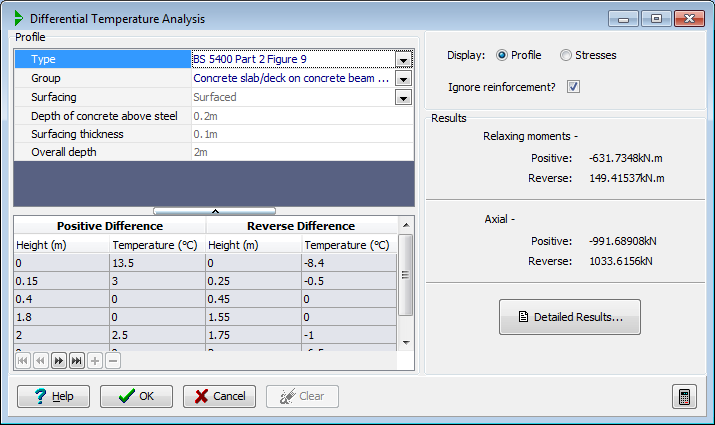Differential Temperature Analysis
Description
This form allows positive and reverse temperature profiles to be specified by either selecting a standard type or by explicit definition. The temperature profile through a bridge deck for different types of construction is given in Figure 9 of BS 5400 Part 2 for a specified surfacing thickness, and Appendix C for other thicknesses.
Once the profiles are defined, a comprehensive series of data checks are carried out before the calculations are performed and the results displayed.
Outline Procedure
The temperature difference profile can be generated, when the Display radio button is set to Profile, by specifying the construction type, surfacing details, and for Group '3' the depth of the concrete slab. The program interpolates where explicit values are not available. The table shows the values generated, interpolating where explicit values are not available. The graphics show the positive and reverse temperature profiles drawn to scale. If the surfacing depth is not 40mm (groups 1 & 2) or 100mm (groups 3 & 4) the Appendix C type should be selected.
The table cannot be edited unless the profile type is switched to the User Defined type. With the User Defined type selected, the temperature may be specified at up to 20 heights through the section, including the top and bottom surfaces.
When the Display radio button is set to Stresses, the stress profiles are displayed graphically, and the principal values are displayed. More detailed results are available in the printout, which can be viewed by pressing the F5 key or clicking the Results button.
Note that the program calculations are based on horizontal strips. If the top or bottom surface of the section is not horizontal, the calculations will not be realistic, and a simplified model of the section may be more appropriate.
Positive differential temperature tends to produce a negative (hogging) moment and tension in a beam. Reverse differential temperature tends to produce a positive (sagging) moment and compression in a beam. The relaxing moments as reported in the results are those which need applying in the analysis to obtain the correct secondary effects.
Form Graphic

Field Help
Type
Select either a standard defined profile or the user defined profile option.
Group
Click on this field to display a drop-down list containing 4 options, which correspond to the 4 construction types labelled groups 1-4 on Figure 9 of BS 5400 Part 2. The groups in full are:
- Steel deck on steel box girders.
- Steel deck on steel truss or plate girders.
- Concrete deck on steel box, truss or plate girders.
- Concrete slab or concrete deck on concrete beams or box girders.
Depth of concrete above steel
For most cases differential temperature profiles may be calculated from the group number and the overall depth of the section (which is calculated and stored by the program, and displayed on the form).
For group 3 construction type however the depth of the concrete slab above the beam is required in place of the overall depth. This value must be specified in this field.
Surfacing
Click on this field to display a drop-down list containing 3 options, which correspond to the surfacing options on the tables of Appendix C of BS 5400 Part 2.
If 'Surfaced' is selected, the field labelled 'Surfacing thickness' will become available.
Surfacing thickness
Access to this field indicates that 'Surfaced' has been selected in the previous field. The default value corresponds to the surfacing thickness of Figure 9 of BS 5400 Part 2, and will yield identical results to selection of that option from the earlier menu.
For surfacing thickness values not explicitly given in the tables of Appendix C, the program will carry out a linear interpolation. Values greater than 200mm will not be accepted.
Positive Temperature Diff. Height/Temperature
Reverse Temperature Diff. Height/Temperature
The table cannot be edited unless the profile type is switched to the User Defined type. With the User Defined type selected, these fields allow positive and reverse temperature profiles to be explicitly specified. The temperature may be specified at up to 20 heights through the section, including the top and bottom surfaces. Values entered under the 'height' column are distances from the TOP of the section.
Any previously standard defined profile will be supplied as default values.
Note that the program calculations are based on horizontal strips. If the top or bottom surface of the section is not horizontal, the calculations will not be realistic, and a simplified model of the section may be more appropriate.
Display
Toggle between Profile and Stresses to change the graphics accordingly.
Ignore reinforcement
The differential temperature primary stresses are calculated ignoring the presence of any reinforcement by default.
Click on this field to un-check the box so that reinforcement is included.
In all cases tendons are ignored.
If the reinforcement is included, it is allowed for only in the section properties used in the calculations, and not in the axial restraint.
Where both short term and long term values of elastic modulus are specified (i.e. for concrete properties) the short term value is used in the analysis.
